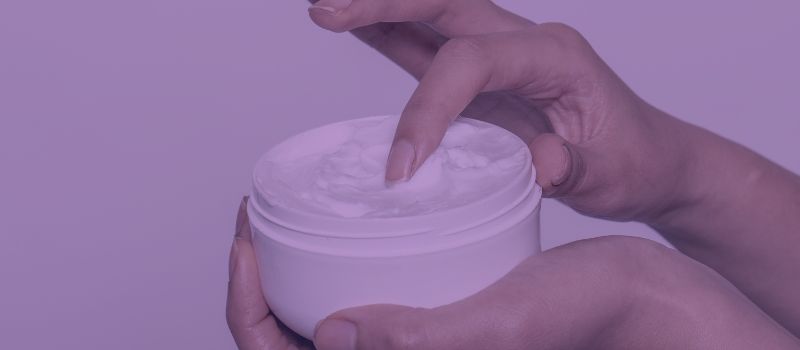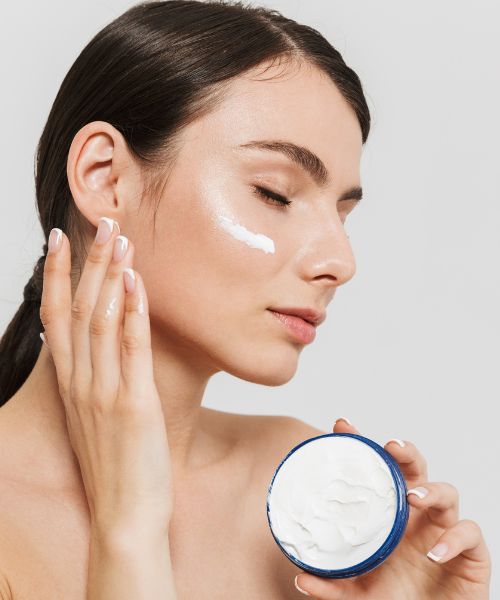Moisturizers are products that many people who are dealing with acne are staying clear of; however, they actually do have their benefits.
Moisturizers prevent your skin from drying out and pumping more pore-clogging oil to compensate for the dryness, which essentially leads to more breakouts.
Moisturizers can also help soothe the skin dealing with inflamed pimples and flatten those big protruding cysts by softening them down.
That being said, despite their benefits, moisturizers can also cause chaos for acne-prone skin, and it all comes down to the ingredients they contain.
So before you give up on moisturizers altogether and miss out on their benefits, read this article to find out some common ingredients in moisturizers that could be triggering your acne.
This is how you can avoid them when shopping for a new moisturizer and find one that will effectively hydrate your skin without causing further breakouts.

Silicones
Silicones are polymers commonly used in moisturizers for their ability to provide a soft and smooth feeling on the skin and help the formula spread easily.
However, although silicones aren’t an issue for everyone, they could be problematic for some acne-prone skin that’s sensitive to these components.
Some silicones in skincare products like moisturizers can be particularly heavy and can clog the pores, trapping bacteria and oil and leading to further breakouts.
Furthermore, silicones are hydrophobic, which means they repel water. For this reason, products containing many silicones don’t rinse away easily and can remain on your skin, creating an environment conducive to breakouts.
The best way to discover whether silicones could be the cause of your acne is by paying close attention to the ingredients list and monitoring whether the products that contain these components are still causing you to break out after cutting out other potential culprits.
If they are, it may be time to seek a moisturizer free of silicones. There are plenty of formulas out there that are specifically designed for acne-prone skin and don’t contain any silicones at all.
To make sure you’re not using any products with silicones, look out for ingredients such as:
- Dimethicone.
- Cyclomethicone.
- Cyclopentasiloxane.
- Cetearyl methicone.
- Cyclopentasiloxane.
Stearates
Stearates are fatty acids commonly used as thickeners that give skincare products a soft, creamy feel.
They can be beneficial to those with dry, cracked, and itchy skin as they are super efficient in creating a layer on the skin’s surface that locks in moisture and prevents dryness.
However, unfortunately, for those with acne-prone skin, stearates, although efficient, are one of the most comedogenic components found in skincare products.
By experimenting with many products throughout the years of running my blog, I have noticed that my skin will react and break out even if there’s a single clogging stearate in the product I’m using.
It’s so bad, in fact, that my skin couldn’t get used to tretinoin cream, which is a topical medication prescribed to treat severe acne, simply because of the few stearates like stearic acid, stearyl alcohol and isopropyl myristate in it.
My skin kept purging and breaking out way past the usual purge phase, which can last anywhere from 8 weeks to 6 months.
So, if you’re dealing with acne, it’s best to avoid stearates entirely and opt for a moisturizer that doesn’t contain any of these components.
You can easily spot stearates in skincare products because their name pretty much ends with “stearate” or “state” or has “stearic” or some variation of “stearyl” in it.
Common stearates to watch out for are:
- Isopropyl myristate.
- Isostearyl isostearate.
- Cetyl stearate.
- Myristyl myristate.
- Stearic acid.
- Sodium stearoyl lactylate.
Emollients
Similarly to silicones, emollients aren’t always the problem, but some of them could potentially be pore-clogging and lead to breakouts.
Emollients are softening ingredients that cover the skin with a protective film to trap moisture.
They are often used to help manage dry, itchy, or scaly skin conditions such as eczema, psoriasis, and ichthyosis.
And while they can definitely benefit those with certain conditions, they can cause chaos for acne-prone skin, clogging the pores and leading to breakouts.
The most common emollients to look out for are:
- Cocoa butter.
- Petrolatum.
- Lanolin.
On the other hand, certain emollients like shea butter aren’t necessarily comedogenic, and my highly acne-prone skin doesn’t have an issue with this particular ingredient; however, it’s one of those components that affect each person differently.
So, for some, shea butter could be the cause of their acne woes, while it won’t make a difference for others, even if their skin is acne-prone. In any case, it’s something to consider when purchasing a moisturizer.
Oils
Oils and emollients go hand in hand, but I prefer placing them in different categories simply for the sake of clarity.
Now, similarly to emollients, oils come with a lot of benefits.
They offer a wide range of vitamins, minerals, and fatty acids that help nourish and protect the skin, aiding in healing skin conditions like eczema, psoriasis, and even unruly rosacea.
And while oils are beneficial in many ways, they can be a bit of a double-edged sword for those dealing with acne.
For example, acne is often the result of a compromised skin barrier that’s not functioning properly, and thus the process of natural lubrication through our sebum and shedding of skin cells is all mixed up, which has resulted in a high level of sebum production and clogged pores.
So, applying certain oils can sometimes help acne-prone skin as it can help normalize this process, repair the skin barrier, and help it retain moisture, thus reducing the amount of sebum produced.
However, these same oils that are beneficial for some individuals dealing with acne can be disastrous for others.
So, it’s important to be aware of the oils and their comedogenic potential before making any decisions since some oils are more likely to clog the pores than others.
Common oils with a high comedogenic potential that you should avoid if you’re dealing with acne are:
- Coconut oil.
- Vegetable oil (like sunflower seed oil and olive oil, often found in moisturizers.)
- Wheat germ oil.
- Argan oil (frequently found in haircare products that rub off on the skin and cause breakouts.)
- Palm oil.
- Soybean oil.
On the other hand, you have oils like squalane, jojoba, and rosehip oil which generally have the green pass by many professionals that claim they have a low or non-existent comedogenic potential, making them the perfect candidates for acne-prone skin.
However, with that being said, these oils definitely have the potential to clog the pores of certain people, so it’s important to keep that in mind before buying products that contain them simply because, according to someone, they are “non-comedogenic.”
Therefore, if you are dealing with acne, no matter how “non-comedogenic” you think the oil may be, stay away from all oils in skincare products, particularly in moisturizers, as these are often combined with other emollients, silicones, and stearates, so you are only doubling and tripling your chances of having a breakout.
Fragrance
Fragrance in skincare products isn’t a component that will clog your pores and cause you to break out.
However, fragrance, perfume, and fragrant components such as essential oils are highly irritating and don’t serve any purpose in a skincare product besides making it smell nice, contributing to the user’s experience, and racking up the price tag.
Therefore, if your skin is already going through an inflammatory condition such as acne, adding something that is known to be highly irritating, like fragrance, can only make things worse, so it’s important to stay away from skincare products with fragrance if you’re dealing with this skin condition.
Additionally, if you are dealing with acne anywhere on the body, such as the chest, bum, and legs, make sure that your body washes, serums, and lotions don’t contain fragrance either cause if they do, you may be bombarding your skin with a constant dose of inflammation that prevents it from healing.
Which are the Best Moisturizers for Acne-Prone Skin?

If you have acne-prone skin, it can be tough to find a moisturizer that doesn’t make your skin break out even more.
Most of the time, people with acne-prone skin feel like they have to give up on using moisturizers altogether, but this doesn’t have to be the case!
The best moisturizers for acne-prone skin are those that are oil-free, noncomedogenic, and fragrance-free. Click the link to see my best recommendations.

My name is Simone and I am a certified skin specialist. I created this website to teach my readers how to take great care of their skin and I also like to occasionally share my honest opinions on skincare products I’ve tried. You can learn more about me here.
